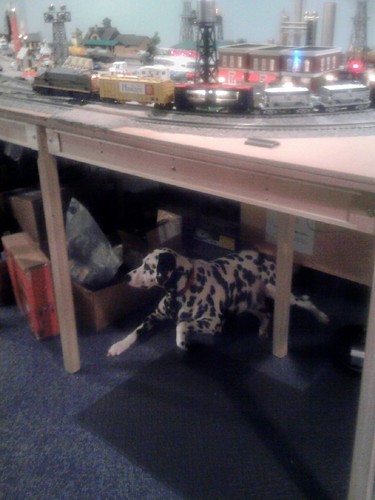Homasote board OR Styrofoam?
What is your choice and why!
I am in the process of building my layout and always used Homasote board.
This time around I'm thinking of using Styrofoam.
Original Post
|




|
Replies sorted oldest to newest
quote:Originally posted by chuck:
I'd use the Homasote (or similar product) under the track as primary road bed and use the styrofoam for scenic bases.
quote:the urban legend of using it as sound deadening somehow began and was passed on. Smile
quote:Originally posted by leavingtracks:
Another consideration could be a product called "Quiet Brace". I have used this for my layouts for over 20 years. It meets all of the requirements stated above including sound deadening plus it is fairly light in weight. It can be cut with a box cutter or with any traditional powered cutting tool. I used it over the entire layout including upper and lower levels because one can simply plant scenery into its surface. Quiet Brace is available at most Home Depot or Lowes but can be found at certain local hardware building centers. It costs from $7 to $10 for a 4 by 8 foot sheet.
Alan
quote:Originally posted by RickO:
I guess its all relative, but I thought pink insulation made a huge difference in sound versus what fastrack sounds like on plywood
quote:How are homosote and OSB related?

quote:Originally posted by gregj410:
Homosote because I got a bunch of it for free and it's what every one else was doing, so I figured it couldn't be bad.
quote:Originally posted by gg1man:quote:Originally posted by RickO:
I guess its all relative, but I thought pink insulation made a huge difference in sound versus what fastrack sounds like on plywood
Hi Rick, if you really wont to make a difference with the sound coming from Fast Track try using some soft foam such as the product used under floating hardwood floors. Cut the foam so it fulls the underside of the Fast Track, Lay this over Homasote being careful not to run your mounting screws through the Homasote and into the plywood.
To me it makes the track run much quieter. But try a few feet only at first, sound can be relative to each listener.
Though Fast Track is a great system and most of us have alot of good things to say about it, it's sound quality is not one of them.
MTH's Real Track is probably the most quite of all the preformed track systems, but I feel the above technique improves the sound level of that as well.
quote:Originally posted by Garfield:quote:Originally posted by gregj410:
Homosote because I got a bunch of it for free and it's what every one else was doing, so I figured it couldn't be bad.
How did you cut the beveled edge?



I just finished my initial layout.
Lazy L
5 x 9 x 11
I used OSB Screwed to the rafters and then Glued Homosote to the OSB.
NO NAILS through the Homosote.
I am very pleased with the amount of sound deadening is has given me.
A few weeks back I read a post on here about laying down 2" Black HVAC Foam Padded tape under the Fastrack for even more sound deadening. I am going to try that on the back 11 and see if that has any sound absorbtion versus not having it. RESULTS Tonite.
Noise free! ![]() Not!
Not!
Access to this requires an OGR Forum Supporting Membership
